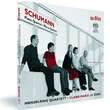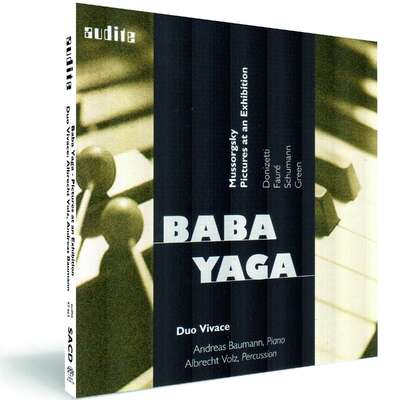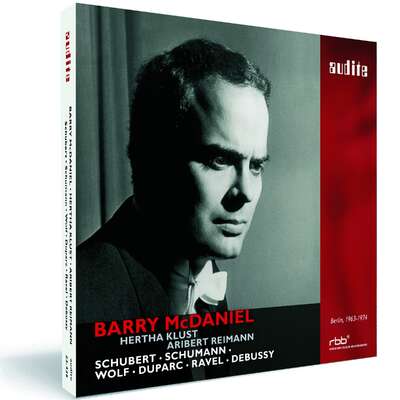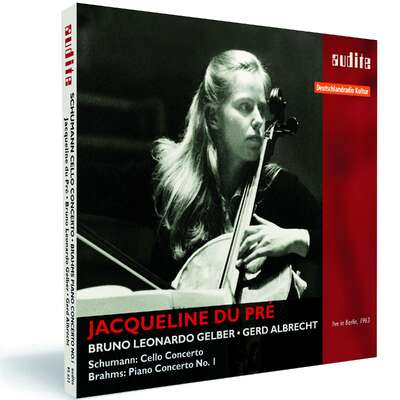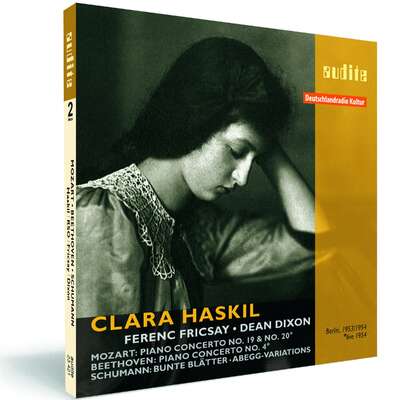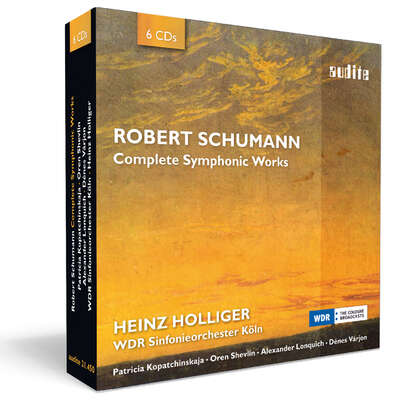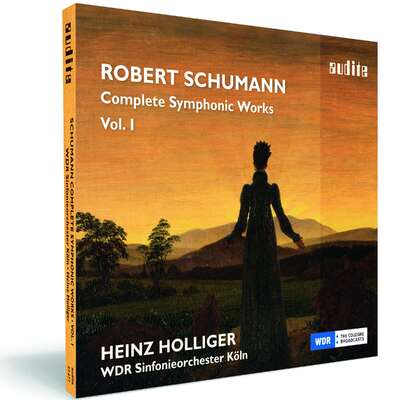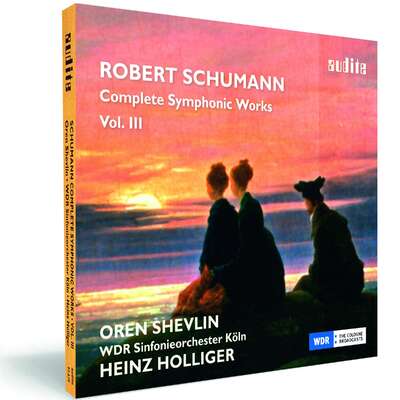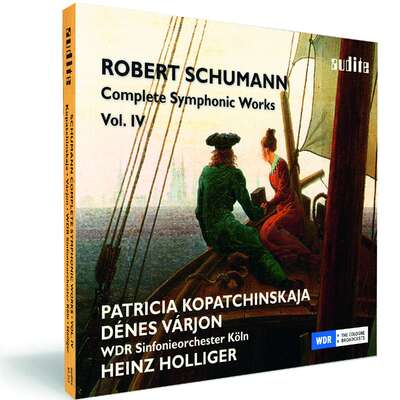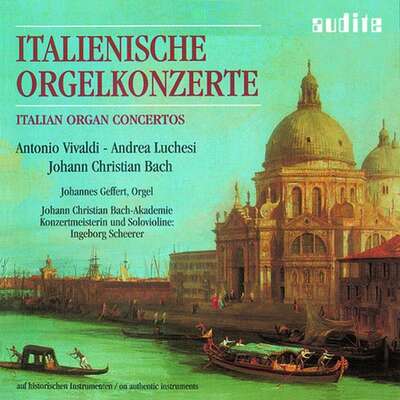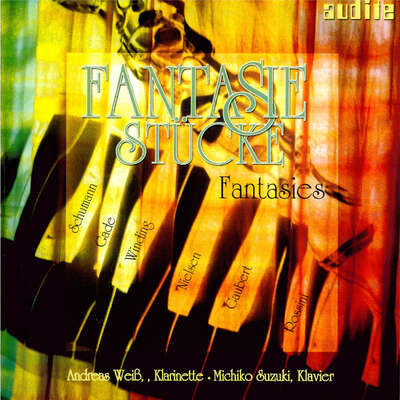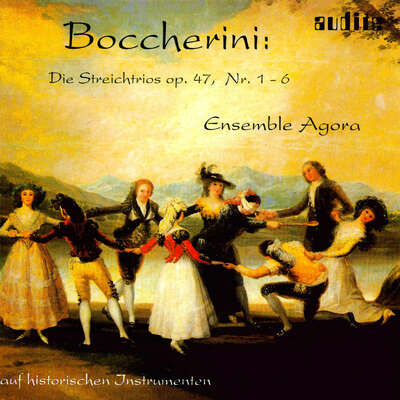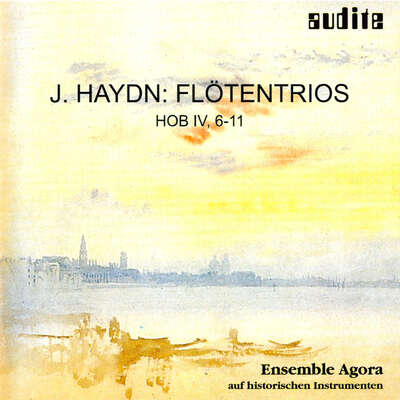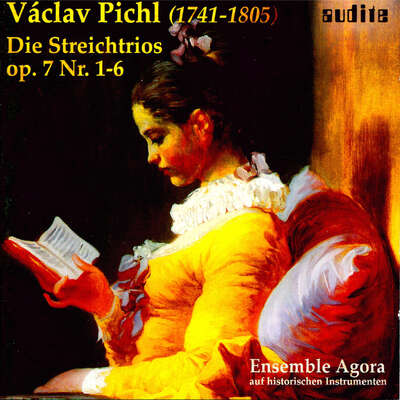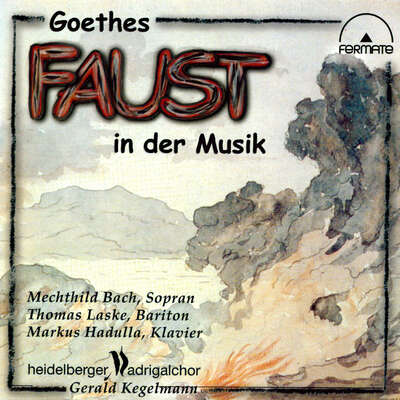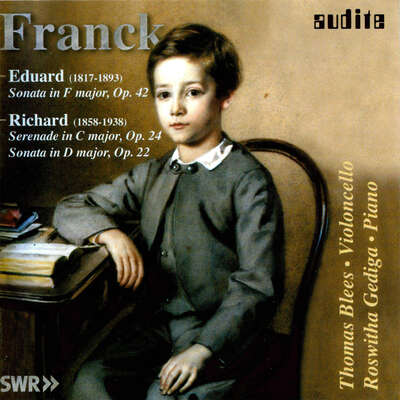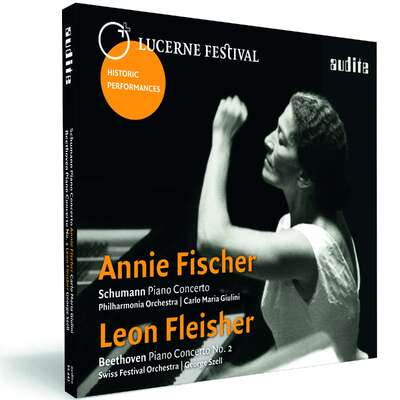
Robert Schumann composed, almost in a frenzy, his two works for strings and piano during the “chamber music year” of 1842. The quintet Op. 44 and the quartet Op. 47, high lights of nineteenth century chamber music, are works of exuberant energy and romantic internalisation. The piano part which Schumann intended for his newly wedded wife, Clara, is played by Claire-Marie Le Guay on this recording with the Mandelring Quartett.more
"Jedenfalls sind hier, sowohl für das so beliebte Quintett, als für das herbere, wegweisende Quartett, faszinierende Aufnahmen entstanden, die auch durch ihre aufnahmetechnische Qualität und Transparenz, im SACD-Verfahren, zu neuen Referenzeinspielungen geworden sind. Bravo!" (Pizzicato)
Details
| Robert Schumann: Piano Quartet & Piano Quintet | |
| article number: | 92.574 |
|---|---|
| EAN barcode: | 4022143925749 |
| price group: | ACX |
| release date: | 4. June 2010 |
| total time: | 35 min. |
Bonus Material
- Excellentia Award_Pizzicato 102010
-
Portrait Marie-Claire Le Guay
Pianiste n° 87 (juillet - aoút 2014)
Informationen
In his maturity Robert Schumann tended to internalise musical genres systematically and then to try them out in a creative frenzy. After the “song year” of 1840 and the “symphonic year” of 1841, his “chamber music year” followed and saw the creation of three string quartets and two of the nineteenth century’s most beautiful chamber pieces with piano. In the autumn of 1842, in a creative frenzy, Schumann composed the quintet Op. 44 and the quartet Op. 47 – the piano part was of course intended for his newly wedded wife Clara. In both works the energetic, even jubilant atmosphere of the outer movements, combining Mozart’s vitality, Bach’s polyphony and Schumann’s dreamy disposition, is ravishing. In the middle movements, delicate Scherzi à la Mendelssohn and two large-scale slow movements can be found: an expressive funeral march in the quintet and an expansive cantabile in the cello part of the quartet, which has become one of the most popular movements amongst Schumann’s chamber works.
In this new recording of these works, the Mandelring Quartett join forces with French pianist Claire-Marie Le Guay. A Winner of numerous international competitions Claire-Marie Le Guay plays regularly in the important international concert venues, appearing in solo recitals as well as in solo concerts with orchestra. In addition, her passion for chamber music has led her to play with noted soloists and ensembles.
Reviews
Image Hifi | 2/2014 | Heinz Gelking | February 1, 2014 Auf dem Gipfel der Romantik: Klavierquintette von Schumann, Brahms und Dvořák
Das in Jahrzehnten eingespielte „Geschwisterquartett“ schöpft Kraft und Gewicht aus perfekter Abstimmung. [...] Dies ist eine gute Aufnahme, ohne Manierismen und unter Meidung irgendwelcher Extreme auf hohem Niveau musiziert, zudem in außerordentlicher Klangqualität.Mehr lesen
Fipps - Das Magazin | Mai 2011 | Georg Rudiger | May 1, 2011
Für seine Schumann-CD hat das Mandelring Quartett erstmals die französische Pianistin Claire-Marie Le Guay engagiert. Das Zusammenspiel gelingtMehr lesen
Fono Forum | Februar 2011 | Ingo Harden | February 1, 2011 Forsch
Das Mandelring-Quartett hat seine Qualitäten oft genug unter Beweis gestellt, und die Französin Claire-Marie Le Guay, die sich als 20-Jährige 1994Mehr lesen
Insgesamt also eine vorwiegend forsche, unvergrübe1te und musikantisch schwungvolle Darstellung der beiden großen Kammermusikwerke des Vorjahres-Jubilars. Zu den unanfechtbaren Vorzügen der Produktion zählt immerhin, dass hier niemand im Egotrip aus der Reihe tanzt (wie manchmal im Luganer Mitschnitt von Argerich "and friends") und das Ensemble den Verführungen "interessant" überzogener oder überdehnter Tempi (wie sie am ungeniertesten Paul Gulda und die Hagens vorführten) nicht nachgab.
American Record Guide | 01.01.2011 | January 1, 2011
Audite’s companion work is Schumann’s Piano Quartet performed by Germany’s Mandelring Quartet and Claire-Marie Le Guay. The performances of bothMehr lesen
Gramophone | December 2010 | David Threasher | December 1, 2010 Claire-Marie Le Guay takes centre stage in joyful and engaging performances
This is an outgoing performance of Schumann's Piano Quintet, one able to stand its ground among the recordings that topped my survey of the workMehr lesen
The Piano Quartet, too, comes in a winning performance, even if these players struggle to achieve the Mendelssohnian lightness of touch offered by Martha Argerich and her all-star Lugano line-up. The balance is slightly better here, the strings more audibly separated and better able to penetrate in the occasionally thick textures. In all, this pairing offers Schumaniacs an enjoyable and often compelling hour, and would equally provide an ideal introduction to those wishing to make the acquaintance of these two pinnacles among Schumann's chamber music.
Kulimu | Heft 2 2010 | Ulrich Alberts | November 19, 2010 Energiegeladener Beitrag zum Schumann-Jahr
In diesem Jahr gedenkt die Musikwelt des Komponisten Robert Schumann, derMehr lesen
Fanfare | Issue 34:2 (Nov/Dec 2010) | Jerry Dubins | November 1, 2010
There are quite a few excellent recordings to choose from that pair these two works: the Cleveland Quartet (Sony), the Schubert Ensemble (ASV), theMehr lesen
Whether it has to do with the recording itself, the placement of the musicians on the stage, the acoustics of the Bayer Kulturhaus in Leverkusen, Germany, where the performances were recorded, the extraordinarily transparent playing of the Mandelring Quartet, or some combination of the above, I have never heard such detail emerge from these scores. It’s almost like hearing these pieces for the first time.
Let me just cite some examples. At the very beginning of the quartet, in the slow introduction, each entrance of the strings seems to materialize out of the piano’s decaying notes as they hang in the air, creating a magical atmosphere of expectancy. Or, take the rapid downward run that announces the development section at 4:12. In other recordings I’ve heard, it’s just a rapid blur, kind of like the effect of a glissando on the piano. But here the individual notes are heard distinctly. Next, take the passage beginning at 5:19. So often what is heard in the piano at this point is an indistinct rumbling in the bass, but here you realize that in counterpoint to the strings the piano is actually playing a modulating sequence based on the first four notes of the Allegro. These may seem like little things, and individually they are; but when you put them all together, they add up to a performance of exceptional sharpness and character, not to mention raising one’s appreciation of Schumann’s ingenuity.
At :09–:12 in the Scherzo, as the strings buzz away at their busywork, I don’t think I ever noticed before that the piano has this really neat little rhythmic counter figure—da-rum-bum-bum-bum. This is playing that points out every accent along the way and manages to highlight every hand-off of material from one voice to another even amid one of the fleetest movements in the chamber music repertoire. The Andante cantabile pulsates with lump-in-the-throat throbbing, and the Finale displays such exactitude and cleanness of execution that it actually sounds much faster than it is. At 7:33, it’s only four seconds faster than the Beaux Arts.
Everything I’ve said about the Mandelring’s performance of the quartet applies equally to the quintet. It’s an exceptionally revealing reading in which every detail is laid bare. What I marvel at is how carefully prepared, rehearsed, and controlled these performances are—as if nothing has been left to chance—yet how spontaneous and animated they still manage to sound.
Timing, as they say, is everything. Unfortunately, another recording of Schumann’s piano quartet with the Eaken Trio came to me in the same batch of review assignments as this one, a performance that could not help but suffer in comparison. I’ve heard a number of the Mandelring’s CDs, and even reviewed two or three of them in prior issues, and while the ensemble has always impressed me favorably, quite honestly I was not prepared for anything of this caliber. Other contributors—namely Brenesal, Anderson, McColley, and Laurson—have all spoken of the Manderling’s alertness, exceptional coordination, and scrupulousness in attention to detail. But this Schumann disc passes beyond all that into the rarefied realm of the sublime.
I haven’t yet made my final selections for this year’s Want List, but if this release isn’t on it, I’ll be as surprised as anyone. Need I say, recommended with the greatest urgency?
www.ResMusica.com | 9 octobre 2010 | Christophe Le Gall | October 9, 2010 Claire-Marie Le Guay et le Quatuor Mandelring interprètent Schumann
Le hasard fait-il vraiment bien les choses ? Alors que paraît chez AlphaMehr lesen
Pizzicato | N° 206 - 10/2010 | Guy Wagner | October 1, 2010 Neue Referenzeinspielungen
Nach ihren herausragenden Deutungen der wichtigsten Schubert-Quartette und ihrer Integrale der Quartette von Shostakovich, die Maßstäbe setzt,Mehr lesen
Und so können sie denn auch den beiden Werken ganz neue Akzente abgewinnen. Die Gestaltung der beiden Werke ist derart frisch, spannend, intensiv, dass man nur noch bewundernd und begeistert zuhören kann. Dabei fragt man sich immer wieder, was man am meisten bewundern soll: das elegante, feine und temperamentvolle Spiel der jungen Französin oder die Wärme, Intensität und Klangschönheit des Spiels der Geschwister Schmidt und des Bratschers Roland Glassl. Jedenfalls sind hier, sowohl für das so beliebte Quintett, als für das herbere, wegweisende Quartett, faszinierende Aufnahmen entstanden, die auch durch ihre aufnahmetechnische Qualität und Transparenz, im SACD-Verfahren, zu neuen Referenzeinspielungen geworden sind. Bravo!
www.classicstodayfrance.com | Octobre 2010 | Christophe Huss | October 1, 2010
La première caractéristique de ce disque est la perspective sonore qui,Mehr lesen
Classic Fun Magazine | October 2010 | JD | October 1, 2010
This accomplished team sounds so desperate to make Schumann's passionateMehr lesen
Classica – le meilleur de la musique classique & de la hi-fi | n° 126 octobre 2010 | Antoine Mignon | October 1, 2010 Robert Schumann
Dans ses Musikalische Haus-und Lebens-Regeln – littéralement RèglesMehr lesen
klassik.com | 9. September 2010 | Aron Sayed | September 9, 2010 | source: http://magazin.k... Pflichterfüllung
Man durfte der Schumann-Aufnahme des Mandelring-Quartetts mit der PianistinMehr lesen
www.SA-CD.net | 25 august 2010 | krisjan | August 25, 2010
I have enjoyed the performances of the Mandelring Quartet in both SchubertMehr lesen
Schwäbische Zeitung | Freitag, 20. August 2010 / Nr. 191 | Reinhold Mann | August 20, 2010 Besuch bei Schumann
Die neue Doppel-CD des Pianisten Herbert Schuch könnte man leichtMehr lesen
www.SA-CD.net | 10 august 2010 | Polly Nomial | August 10, 2010 Another great disc from the Mandelring Quartett
The Mandelring (minus their "first" violinist Sebastian Schmidt) have onlyMehr lesen
Westdeutsche Allgemeine Zeitung | Dienstag, 10. August 2010 - Nr. 184 | Hajo Berns | August 10, 2010 Faszinierend gut
Es soll ja gewaltig geknallt haben, als in den Sechzigern das JuilliardMehr lesen
Ensemble - Magazin für Kammermusik | 4-2010 August / September | Carsten Dürer | August 1, 2010 Strudel aus Gefühlen
Es sind die beiden vielleicht grandiosesten Kammermusikwerke, die SchumannMehr lesen
Rondo | Juli/August 2010 | Thomas Rübenacker | July 24, 2010 Robert Schumann Klavierquartett und –quintett
Das Mandelring Quartett war nominiert für einen Jahrespreis der deutschenMehr lesen
The Irish Times | Friday, July 23, 2010 | Michael Dervan | July 23, 2010
The obsessive patterning of Schumann’s early output has been muchMehr lesen
Hessischer Rundfunk | hr2 Kultur - Der CD-Tipp vom 16.07.2010 um 13:05 Uhr | Adelheid Kleine | July 16, 2010
Vorhang auf und Bühne frei – so beginnt Robert Schumanns KlavierquintettMehr lesen
WSCL Blog | 02.07.2010 | July 2, 2010
For this Schumann bicentennial year, a new recording of the Quartet andMehr lesen
International Record Review | July/August 2010 | John Warrack | July 1, 2010
Schumann's Piano Quintet has had literally dozens of performances on record, but in only about half a dozen cases is it coupled with the Quartet . OneMehr lesen
Clarity is also crucial in the many passages in these two works when Schumann indulges what he called his Fugenpassion, his love of the Bach fugues over which the newly marrieds pored. The bold opening theme of the Quintet almost certainly derives from a Bach prelude in the Well-Tempered Clavier, and the lucidity with which Le Guay articulates this is admirable. She is strong and sure of finger, in the Quintet filled with nervous energy in the episodes of the curious little March, and she is Molto vivace indeed in the Scherzo so marked. There are echoes here of Mendelssohn, whom they admired and who suggested some revisions (and who was one of many who admired Clara, to Robert's brief irritation). The final Allegro ma non troppo needs a clear head as well as clear fingers to hold it all together, but all is well here with a strongly conclusive finish to the work. The Quartet is in some ways a more original piece than the more finished Quintet, and well deserves to be placed beside it. The movements include a Scherzo in racing octaves reflecting Schumann's love of Weber's piano writing (he must have known the First Piano Concerto), a beautiful singing Andante that sets off here with some lovely cello playing, and, relished by the players, lots of fugal fun in the finale.
International Piano | July / August 2010 | Edward Bhesania | July 1, 2010
Hideyo Harada trained in her native Japan, as well as in Europe and, latterly, at the Moscow Conservatory with the venerable Victor Merzhanov (stillMehr lesen
Her Kreisleriana displays the same combination of athleticism and poetry. An increasingly transparent and deftly spun middle section in no.3, 'Sehr aufgeregt', emerges into a fiery climax, amply underlining the wide mood-swings of Johannes Kreisler – the unstable, borderline-genius music-master of E.T.A. Hoffmann's creation, on whom Schumann based this set of fantasias.
Young Brazilian-born, Paris-based Felipe Scagliusi features Schumann's Piano Sonata no.3 as the focus of his new disc, a work still unjustly neglected despite being championed by Horowitz. Scagliusi is strongest here in the darkly-tinged slow variations movement, based on an Andante theme by the young Clara Wieck. What hinders the rest of the sonata is a lack of surging heroism, which tends to flatten even Scagliusi's unarguably impressive quicksilver articulation in the Finale. 'Tumult and chaos are expressed in a grandiose style,' Harry Halbreich is quoted as saying of the first movement in the booklet notes. Something of this spirit seems to escape Scagliusi. The sonata's flattened trajectory spills into the first of the three op.28 romances in particular, and in no.2 a more lingering, cantabile line is necessary. Scagliusi has scaled the technical demands of these works, but the peak of spontaneous expression seems a short way into the distance.
Claves' ongoing series of Schumann's complete solo piano works continues with Swiss pianist Francesco Piemontesi. There is an immediacy to his characterization of themes, a strikingly coloured quality throughout – even in the tumultuous first movement of the third sonata – though some listeners may wish for a shade more heft. This is neat and natty Schumann, and no worse for it: its freshly sprung feel comes to the fore in the third sonata's Scherzo, while the Finale sparkles with clarity.
Piemontesi's control of intensity in the Fantasie is one of its key features, giving the hymn-like 'Im Legendenton' (In the manner of a legend) section an unusual transparency. His distinctive musical personality and unshowy approach bring a new lightness, for example, to the often stridently march-like second movement of the Fantasie. The turbulent Allegro vivace first movement of the sonata no.1 is served up with a degree of light majesty and the second-movement Aria achieves a twilit colouring. This isn't the gutsiest Schumann playing, but it is unswervingly sure-footed, and attests to a genuine talent. Though the works on Tzimon Barto's disc are, for many, not top-drawer Schumann, it's rewarding to have the two piano-concertante works (op.92 and op.134) as bedfellows. Nestling between them is the rarely heard 'Ghost' Variations, though with the five variations all reflecting the stasis of the theme, this is perhaps a piece that appeals mainly to collectors.
The pianist's role in op.92 is more restricted than in op.134, which gives American Tzimon Barto more scope to flex his pianistic muscle, which he does with flair. The Six Etudes were written, following a period of intensive counterpoint study, for a kind of pedal extension device placed under the grand piano, to emulate the organ pedals. These are wonderful pieces, and show Eschenbach and Barto well matched both in touch and in temperament.
At around 56 minutes' duration, Claire-Marie Le Guay's CD may not be the most generously filled release, but this German quartet and French pianist give unstintingly of their considerable energies. In the first movement of the Piano Quartet, the languorous Sostenuto introduction bursts into an Allegro with focused rhythmic drive. The following Scherzo has a brilliant sense of urgency. The piano sound is present enough to highlight Le Guay's agile touch, but it blends in well with the ensemble as part of a soundscape that is rich and detailed.
In the Piano Quintet the risingscale figure of the Scherzo is bracingly articulated, and the same movement's rustic second trio is as engaging as its bristling coda. The finale's closing fugue, which combines its own march-like theme with the first movement's opening theme, gathers a formidable momentum.
Wochen-Kurier | Mittwoch, 30. Juni 2010 - Nr. 26 | Michael Karrass | June 30, 2010
In seinen reifen Jahren neigte Robert Schumann dazu, sich die musikalischenMehr lesen
Sunday Times | 27 June 2010 | David Cairns | June 27, 2010
Three of Brahms’s most substantial works, the Piano Quintet and the firstMehr lesen
Bayern 4 Klassik - CD-Tipp | 22. Juni 2010 | Fridemann Leipold | June 22, 2010 Klavierqartett und -quintett
Der Sponsor dieser CD hat sie zusammengebracht und auf Anhieb ist der französischen Pianistin Claire-Marie Le Guay und dem renommierten deutschenMehr lesen
Dass sowohl die Pianistin als auch das schon seit 1983 bestehende Familien-Quartett einst ihre bislang getrennten Karrieren mit einem Preis beim ARD-Musikwettbewerb begonnen haben, ist auch die einzige, überdies rein zufällige Parallele in ihren Biographien. Und doch spielen Le Guay und die Geschwister Schmidt samt ihrem bewährten Bratscher Roland Glassl derart organisch und reaktionssicher zusammen, als hätten sie nie etwas anderes getan. Jung geblieben sind die fünf allemal, wie ihr zupackendes, einfühlsames und unerhört frisches Schumann-Spiel beweist.
Nuancenreich und spannend
An Neuaufnahmen insbesondere des populären Klavierquintetts op. 44 mangelt es bislang in diesem Jubiläumsjahr nicht – mit höchst unterschiedlichem Erfolg haben sich große Pianisten wie Jewgenij Koroliov, Marc-André Hamelin oder Christian Zacharias kürzlich einmal mehr dieses Juwels angenommen. Die musikantischste, nuancenreichste und spannendste Version indes ist nun Le Guay und dem Mandelring Quartett aus Neustadt an der Weinstraße gelungen. Während das Quartett über die Jahre bei uns mit seinen CD-Einspielungen, zuletzt mit einem hochgelobten Schostakowitsch-Gesamtzyklus präsent war, hörte man von Claire-Marie Le Guay hierzulande seit ihrem Wettbewerbserfolg 1995 nicht allzu viel. Zwischenzeitlich hat sie in ihrer französischen Heimat und in den USA reüssiert, gleichfalls eine ganze Reihe von CDs aufgenommen.
Gleichgesinnte Musizierpartner
Es ist jedenfalls eine Freude, ihr auf dieser Schumann-Neuheit in Bestform wiederzubegegnen! Claire-Marie Le Guay überzeugt durch ihr vital pulsierendes, markant griffiges und zugleich elegantes Klavierspiel. In den Mitgliedern des Mandelring Quartetts hat sie gleichgesinnte Partner gefunden, die Schumanns ambivalente, ja zerrissene Gefühlswelt energiegeladen und zärtlich zugleich ausloten, dabei fern jeglicher sentimentalen Weichzeichnerei (die Gefahr liegt beim traumhaften Lyrismus im Andante des Klavierquartetts zumindest nahe).
Derart profiliert interpretiert, rückt das in der Publikumsgunst deutlich abfallende Klavierquartett op. 47 als das fraglos sperrigere, elaboriertere, vermeintlich sprödere Werk ins Zentrum der Aufmerksamkeit. Noch im selben "Kammermusikjahr" Schumanns 1842 kurz nach dem Quintett entstanden, weist es deutlich weiter in die Zukunft voraus als das eingängigere, opulentere Klavierquintett. Der anspringend plastische Sound dieser SACD macht das Hörererlebnis perfekt.
RBB Kulturradio | Freitag, 18. Juni 2010 | Ulrike Klobes | June 18, 2010 Das Mandelring Quartett
Als Geschwister spielen sie schon seit über drei Jahrzehnten zusammen. Sebastian, Nanette und Bernhard Schmidt. Zusammen mit dem Bratschisten RolandMehr lesen
Claire-Marie Le Guay
ist eine französische Pianistin, die gerade 36 Jahre alt geworden ist. Mit 17 Jahren beendete sie ihr Klavierstudium in Paris und setzte ihre Ausbildung u.a. bei Dmitri Bashkirov, Andreas Staier und Leon Fleisher fort. Sie verfügt nicht nur über viel Orchestererfahrung (London Philharmonics, Orchestre de Paris, Chicago Civic Orchestra usw.), sondern ist auch regelmäßig auf kammermusikalischen Wegen unterwegs. Zu ihren regelmäßigen Partnern gehören u.a. Gidon Kremer, Eric le Sage oder David Garret. Momentan ist Le Guay Artist in Residence am Pariser.
Beeindruckendes Zusammenspiel
Die vier bzw. fünf Musiker schaffen es, eine unglaubliche Spannung aufzubauen, die von allen Spielern getragen wird und bis zum Schluss eines einzelnen Satzes nie abreißt. Das kommt zum einen durch die sehr filigrane Gestaltung der Dynamik, es werden ganz weite Bögen vom sachtesten Pianissimo bis hin zum mächtigen, explosiven Tutti gesponnen. Zum anderen ist das nicht allzu schnelle Tempo, das das Quartett gewählt hat, sehr zum Vorteil der beiden Stücke. Da wird nicht gerast, nicht gehetzt, alles bleibt klar und transparent. Somit transportieren das Mandelring Quartett und Claire-Marie Le Guay sehr schön Schumanns eigentliches Anliegen bei diesen beiden Stücken: das gleichberechtigte Auftreten der einzelnen Instrumente. Sowohl die einzelnen Quartettmitglieder als auch die Pianistin haben ihre virtuosen, brillierenden Passagen, können sich aber im Handumdrehen wunderbar zurücknehmen und dem jeweils anderen die Bühne überlassen.
Fehlender Glanz
Alles in allem ein Album, das Schumann nicht vor Schmalz triefen lässt, und dadurch rbb Kulturradio | Robert Schumann: "Klavierquartett / Klavierquintett" in Gefahr gerät, an manchen Stellen doch zu hart und unglänzend zu werden. Insbesondere bei der Bratsche hätte man sich doch öfter ein stärkeres Vibrato gewünscht, sie klingt an einigen Stellen einfach kraftlos und wirkt in dem ganzen wunderbaren Fluss wie ein störender Stolperstein. Auch das Violoncello ist an manchen Passagen etwas zu nüchtern geraten.
schallplattenmann.de | #678, 14. Juni 2010 | Sal Pichireddu | June 14, 2010
Schon ihre Schubert- und Shostakovich-Aufnahmen konnten voll überzeugen,Mehr lesen
Ostthüringer Zeitung | Freitag, 11. Juni 2010 | Dr. sc. Eberhard Kneipel | June 11, 2010 Jubiläumsgaben für Schumann
Seit dem 8. Juni ist Robert Schumann der Jubilar vom Dienst: Sein 200.Mehr lesen
Arte | ARTE-Journal vom 8. Juni 2010 um 19:00 Uhr | Dr. Marco Stahlhut | June 8, 2010
Eine mitreißende deutsch-französische Koproduktion – das renommierteMehr lesen
Die Welt | 8. Juni 2010 | June 8, 2010
Neue Aufnahmen zum Schumann-Jahr
Klaviersolowerke von Eric Le Sage bis zur vorletzten Folge fortgeschritten
Die CD-Produzenten haben sich zum Schumann-Jahr zurückgehalten. Zwar gibtMehr lesen
Mitteldeutscher Rundfunk | 7. Juni 2010 | - | June 7, 2010 Klassiker neu eingespielt
1842 war Schumanns "Kammermusikjahr", ein unbekanntes Terrain für denMehr lesen
NDR Kultur | Freitag, den 4. Juni um 15:20 Uhr | Dagmar Penzlin | June 4, 2010
An einer Ringstraße, gesäumt von Mandelbäumen, da lag der erste Probenraum des Mandelring Quartetts. Daher also der Name Mandelring – wer eineMehr lesen
Seit 1983 gibt es das Mandelring Quartett. Zur Kernbesetzung gehören die drei Geschwister Schmidt, zwei Brüder, eine Schwester. Und mittlerweile kann das Ensemble auf eine internationale Karriere zurückblicken. Hoch gelobt werden auch seine Plattenaufnahmen. Zum Schumann-Jahr steuert das Mandelring Quartett eine neue CD bei – gemeinsam mit der Pianistin Claire-Marie Le Guay. Auf dem Programm stehen Schumanns Klavierquintett und das Klavierquartett. Dagmar Penzlin stellt uns das Album vor.
[Musik: Klavierquintett op. 44, Kopfsatz (Tr. 5 - L: 0’15'')]
Krisenmusik. Oder mehr noch: eine Antwort auf eine Krise - das ist das Es-Dur Klavierquintett von Robert Schumann. Als er sich 1842 der Kammermusik intensiver zuwandte, kriselte die Gattung. Schumanns Zeitgenossen traten auf der Stelle. Doch dann dieses Klavierquintett: mit Mut und Kraft schreiten die Akkorde nach vorne. Und immer wieder folgt auf‘s melodienselige Nachdenken und aufgebrachte Diskutieren Tatendrang.
[Musik: Klavierquintett op. 44, Kopfsatz (Tr. 5, ab 2’08’’ - L: 0’10'')]
Ein Signal. Klangtheater, das auch nicht den Blick in den Abgrund scheut. Im zweiten Satz erstickt ein Trauermarsch allen Optimismus.
[Musik: Klavierquintett op. 44, 2. Satz (Tr. 6, ab 0’05’’ - L: 0’09'')]
Doch dann geschieht das Unerwartete: das Trauermarsch-Thema begehrt quasi auf.
[Musik: Klavierquintett op. 44, 2. Satz (Tr. 6, ab 5’09’’ - L: 0’13'')]
Noch heute – oder besser: gerade heute – entfaltet Schumanns populärstes Kammermusikstück einen Sog: das musikalisch komplexe und zugleich so emotionale Kräftespiel wühlt auf. Zumal wenn es so energiegeladen daherkommt wie in der Interpretation des Mandelring Quartetts. Gemeinsam mit Claire-Marie Le Guay, einer erfahrenen Kammermusikerin, legt das Ensemble das Experimentelle in dieser Musik offen, so dass schwärmerische Töne manchmal fast schon wie ein romantisches Stil-Zitat wirken. Und das alles musiziert mit Präzision, Leidenschaft und hörbarem Spaß am schnellen Wechsel der Stimmungen.
[Musik: Klavierquintett op. 44, 4. Satz (Tr. 8, ab 5’58’’ - L: 0’13'')]
Etwas blasser wirkt da im Vergleich das Es-Dur-Klavierquartett. Insbesondere dem ersten Satz fehlt es an dramatischer Spannung, an beherzten laut-leise-Kontrasten. Doch schon im Scherzo kichern die Achtelläufe ausgeschlafen; das Seufzen und Schmachten im dritten Satz mündet schließlich in das Fugen-Feuerwerk des Finalsatzes.
[Musik: Klavierquartett op. 47, 4. Satz (Tr. 4, ab 6’25’’ - L: 0’13'')]
Das Mandelring-Quartett und die französische Pianistin Claire-Marie Le Guay bescheren Kammermusikfans im Schumann-Jahr eine Aufnahme der Kategorie „Delikatesse“. Mehrmaliger Genuss zu empfehlen!
www.meier-online.de | Mai 2010 - 05/2010 | Ingo Wackenhut | May 1, 2010 Mandelring Quartett – Schumanns Klavierquartett und - quintett
Rechtzeitig vor seinem selbstveranstalteten Hambacher Musikfest vom 2. bisMehr lesen
